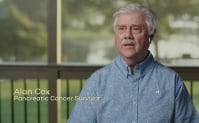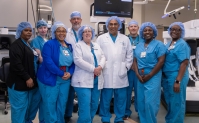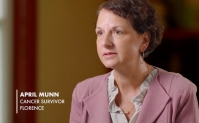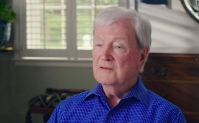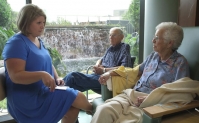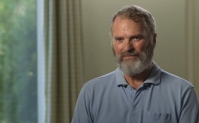You Inspire The Best in Us.
With the many advances in care and treatments, today’s patients have more and more reasons to expect the best outcomes. Here are the incredible stories of our patients and their journeys. Click on a thumbnail and scroll down to view each story.


Spirit and Strength
By Tracy H. Stanton
When Lanell Timmons started cheering, he made history by being the first male cheerleader at South Florence High School.
His cheer experience continued at Francis Marion University. Lanell then joined a cheer company and fell in love with coaching. When his good friend Alex wanted to open her own cheer gym, they worked together to establish Athletic Cheer Force (ACF) in Florence.
“We’ve been on a roll ever since,” Lanell said. “In 2022, I competed in cheer as an adult at the Summit Championship in Florida which is known as the ‘Super Bowl’ of cheer-leading. This was a really great experience, but during that competition, I was having one of the abdominal episodes I had been dealing with for some time.”
After being hospitalized in Florida for treatment, Lanell was discharged just in time to compete and win the Summit.
“However, I knew something was wrong. When people say you know your body – you just know when something doesn’t feel right. You want to make sure you listen to yourself.”
After several emergency department visits over a three-year span, Lanell had become accustomed to hearing ‘everything is fine’ because there was never a diagnosis for his symptoms.
“‘Everything is good.’ That was the answer that I heard time and time again. No one knew what was going on.”
After seeing another physician in Columbia and undergoing a procedure, Lanell was prepared to hear again that everything was fine. Instead, he was informed that he had Stage II Anal Cancer.
“I experienced a wide range of emotions after receiving my diagnosis. I initially felt relieved because I finally had an answer to what I had been dealing with, but also a little shocked.
“I didn’t know how serious this was but once it settled in, I knew I needed the right mindsight before I even started the process of treatment. I had to meditate, focus, pray and really trust that everything was going to be okay,” recalled Lanell.
Lanell’s family doctor referred him to McLeod Oncologist Dr. Arrvind Raghunath and spoke highly of him, adding that the McLeod Centers for Cancer Treatment and Research was the place to go for his treatment.
“Dr. Raghunath was able to answer all of my questions. He kept me calm and in a good headspace throughout my whole treatment process.”
Initially, Lanell underwent radiation and chemotherapy at the same time but it was too much on his body, so he completed all his radiation then resumed chemo.
In the McLeod Radiation Oncology department, Lanell was under the care of Dr. Jordan Gainey. “I love Dr. Gainey. He was cool, calm and collected. Dr. Gainey knew my treatment would be slightly uncomfortable, so he always tried to make me feel as comfortable as possible, which I really appreciated.”
After Lanell began treatment at the McLeod Center for Cancer Treatment and Research, it was so hard on him physically that he was unable to keep working. With no income coming in, Lanell was close to being evicted from his apartment.
Fortunately, during his treatments, Lanell met Sarah Beth Averette, the McLeod HOPE Coordinator. Sarah Beth’s role is to meet every new cancer patient at McLeod and determine how she can help them during their journey with assistance from the HOPE (Helping Oncology Patients Everyday) Fund.
“After talking with Sarah Beth, she explained how she could help me with my rent payments so I would not be evicted as I continued my treatment. Once I met her, it was like a breath of fresh air. She never made me feel like I was less than or that I couldn’t come to her. I will forever be grateful for Sarah Beth and the HOPE Fund donors,” said Lanell.
Lanell completed all of his treatments in April 2025. He has returned to work and coaching. “I don’t feel 100 percent yet, but I’m getting there every day. As a former athlete, I’m used to being able to get up, move and do what I want to my fullest potential.
“That has been the hardest part – getting back to being as agile and strong as I used to be, but I know it’s a process. I’m not trying to rush it. You just have to give it your best and keep moving on.”
-
McLEOD REGIONAL MEDICAL CENTER FLORENCE
843-777-2000 -
McLEOD DARLINGTON
843-777-1100 -
McLEOD DILLON
843-774-4111 -
McLEOD LORIS
843-716-7000 -
McLEOD SEACOAST
843-390-8100 -
McLEOD CHERAW
843-537-7881 -
McLEOD CLARENDON
803-433-3000



-
McLEOD REGIONAL MEDICAL CENTER FLORENCE
843-777-2000 -
McLEOD DARLINGTON
843-777-1100 -
McLEOD DILLON
843-774-4111 -
McLEOD LORIS
843-716-7000 -
McLEOD SEACOAST
843-390-8100 -
McLEOD CHERAW
843-537-7881 -
McLEOD CLARENDON
803-433-3000
 Find a Doctor
Find a Doctor  Locations
Locations  Services
Services 


